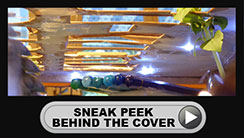
An enthusiastic, self-taught gardener, Tara Lissner is passionate about gardening and eager to share her zeal and knowledge with other gardening fans.
In 2012, she joined forces with Hester Macdonald, a British-trained landscape designer, to launch the Swiss Gardening School.
(Photo by Jean-Luc Pasquier)
Swiss Gardening School
www.swissgardeningschool.com

By Tara Lissner, Swiss Gardening School
From raging snow storms to sunny afternoons in short sleeves the month of March never ceases to surprise. We feel we are just coming out of the cold of winter with length in the day and sunshine on our faces only to be hit with high winds, cold temperatures and snow. At least we know that the garden is prepared and ready for these crazy meteorological outbursts, even the seemingly delicate spring bulbs manage to withstand the wild weather.
For me March signifies the turning point, the new start, the wake up call. The sun is higher in the sky giving my neglected beds the warmth and light they need to come back to life. This of course is also a wake up call for me to get moving. Now is the time to clear these damp and cold beds of the debris from last year, all the frost kissed seed heads that looked so lovely a few months ago are now a soggy mess impeding the progress of my narcissus. I have a busy few weeks ahead of me. I’d just like the snow to stop and for the rain to only fall during the darkest hours of the day.
The vibrance of yellow always takes my breath away in March. The delicate shades of the first primula followed by the pretty narcissus and the billowing branches of the forsythia heralding the end of winter – such joy.

By Tara Lissner, Swiss Gardening School
Harvest is a time of new beginnings, as the long hot summer draws to a close, the hum of traffic increases as schools return to their academic routines and the garden gives its final push of colour and splendor before the weather changes and autumn is really upon us. We have had the most spectacular summer season. The Swiss federal office of meteorology has declared 2018 the third hottest summer since records began in 1864; only 2003 and 2015 were warmer. Rainfall this year has also been record breaking, noticable by its absence, between 20-30% below average. These extreme weather conditions affect the home gardener making planting decisions more and more critical. Right plant right place the byword of Beth Chatto, the well-known British plantswoman, is now more important than ever.
How have you coped with these tricky conditions this summer? My lawn is once again dry and yellow with the soil beneath parched and dusty. I thought the pots on my terrace were large enough to cope with dry conditions but they have proven to not be big enough, note to self even larger pots for next year. Leaves are turning and falling from the trees at a surprising rate much earlier than I’m used to. The fruit on my trees are already mature which caught me a little off guard. Always adapting to changing conditions, there is never a dull moment.
On a more positive note, the roses have been truly magnificent, repeat blooming varieties giving their all for the entire summer – I don’t know how a garden can be complete without a rose. Returning from a trip a few years ago to find courgettes the size of a small dog, I refrained from planting them this year however we have enjoyed weeks of delicious fragrant cherry tomatoes with basil and more green beans than I know what to do with. My direct vegetable seed sowing efforts were less successful. I think the super hot conditions combined with sporadic watering just sunk them. Next year I’ll give in and spend time filling fiddly seed trays with compost and transplant out seedlings when they are robust enough to survive. Something I have not missed this year is slugs. For once the heat seems to have significantly impacted their numbers, let’s hope this means going into autumn there will be even fewer of these pests around to damage our plants. The box wood caterpillar however is never far off and I’ve ended up spraying against this pest already twice this summer. I keep a keen eye out for small white moths, I occasionally spray a jet of water from the hose through the small hedges to see if there are any to disturb. If I find some flying away I next take a closer look for caterpillars and their webbed cocoons. As I’ve mentioned before the best product on the market at the moment is Delfin by Andermatt Biogarten. This product is a drench which must be sprayed onto the shrubs in two parts, two to three weeks apart. Please think carefully before you plant box, while adding structure and form to the garden it now also brings significant maintenance.

By Tara Lissner, Swiss Gardening School
Wow! What a few weeks it has been. Gloriously warm temperatures, big blue skies, t-shirts and sun hats, winter a lifetime away – spring has really arrived, even though it feels like it could be summer. In Switzerland it this year it has been the warmest April for years and years, lucky us no? Or, perhaps not.
I’ve been having an amusing conversation with an Australian friend at the moment, I recently lamented that last weekend was just too hot for gardening (for me that is) and she just laughed and laughed, heat, she suggested, is what it feels like in the Australian desert! It is what we are used to I suppose but for me gardening a few weeks after Easter in 25c is just a little dramatic. I’d much rather a gentle increase in temperatures and enough time for me to acclimatize to the change in the weather. If nothing else this dramatic jump in “heat” leads me to think about the plants. There is a great gardening rule which is “right plant, right place” which means that every plant is a great plant so long as it is placed in its ideal spot, shade for shade loving, sunny for sun loving etc. Baking on my south-facing terrace this week has led me to think that I will give up on the lovely arrangement of cute little pots I’ve had there for the winter and only keep a few of the big ones. I promise to only plant heat tolerant, sun-loving beauties and shall retire the delicate plants and pretty small pots to the shed (sorry, cave) for the summer.

By Tara Lissner, Swiss Gardening School
There is a softening underfoot, a warmth in the air and dare I say that feeling of spring abounds! It’s true we’ve been fooled before; a lovely gentle week in February followed by lots of snow and a wind chill that felt like -16c. But it will come, that light in the day, that stretch in the evening and that warmth in the air that means below zero temperatures are just a memory.
I do so love the optimism of March. Every DIY catalogue that comes through the letter box is packed with the promise of spring with bunnies and daffodils in almost every picture; lawn mowers and garden tools to make every job a breeze. Furniture catalogues encourage us to enjoy outdoor living with new patio furniture, parasols, coffee tables and sofas, to plan dinners and parties with friends. We the gardeners know that this is all just a sales tactic for it is far too early to even begin thinking about outdoor living, we are all preoccupied with outdoor working; beds to dig, mulch to spread, plants to grow, shrubs to prune and seeds to sow.

By Tara Lissner, Swiss Gardening School
This perfect light, golden tones all around and cooler temperatures gently ease us into this new season of Autumn. The summer bedding is fading but trying to hang on continuing to perform in the sunshine, the summer veggie plot is almost at an end with the soft herbs going to seed and the green tomatoes fooling us into thinking that they may ripen on the vine (they will not), the lawn is showing signs of worm casings and a scattering of colourful leaves greets us ever morning – a time of change.
It has to be said that this summer was really fantastic, long days of warm sunshine, almost enough rain to keep the lawn green and that perfect blue sky. A hot summer like this reminds me to take a closer look at my garden. It brings to the forefront the areas I will need to concentrate on when the guests have departed and the rosé is finished. And so the list begins; add even more mulch to keep greater moisture in the beds, explore even more fully hardy but drought resistant perennials to reduce watering, reconsider the choice of planting for the vegetable plot when a holiday is planned – goodness I’m beginning to see a pattern, all of these issues revolve around water, the lack of rain and the need to irrigate. This may have something perhaps everything to do with the fact that I have a south facing garden on a hill with clay soil. Oh the work!









